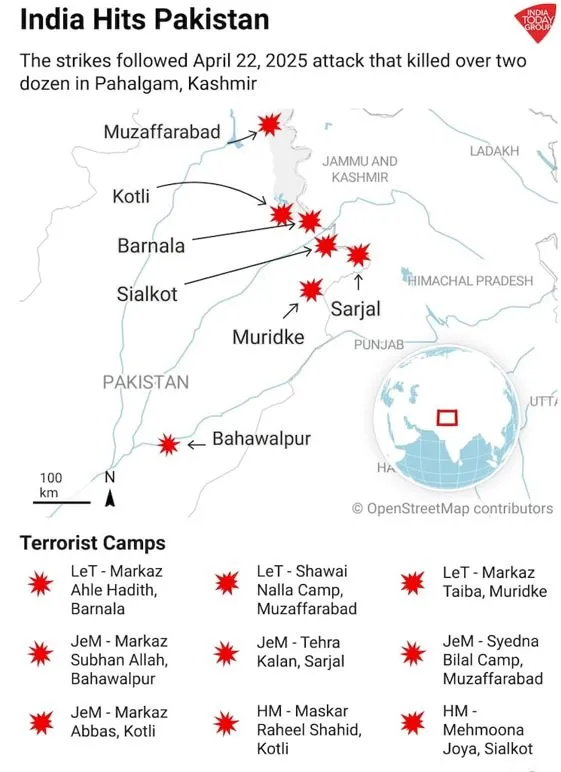

8th May 2025 (11 Topics)
Context
What is Operation Sindoor?
- Operation Sindoor is a meticulously planned military offensive targeting terrorist infrastructure in Pakistan and Pakistan-occupied Kashmir (POK). It wasn't just a big strike against terror infrastructure.
- It was the biggest anti-terror operation inside Pakistan, and the biggest military strike since the 1971 War.
- The immediate reason cited for the operation was to “deliver justice” to the victims of the Pahalgam terror attack, which killed multiple security personnel.
- However, India framed Operation Sindoor not as a one-off reaction but as a response to decades of Pakistan-sponsored terrorism, dating back to the 2001 Indian Parliament attack.
- India shifted the causal chain from the Pahalgam attack to a long-term pattern of cross-border terrorism, signaling that no major act of terror will be seen in isolation.
- Terrorist groups like Jaish-e-Mohammed and Lashkar-e-Taiba — both UN-designated entities — were highlighted as persistent actors behind these attacks.
- India described Operation Sindoor as:
- “Focused”
- “Measured”
- “Non-escalatory”
- This signals to:
- Pakistan: Future escalation could involve conventional military targets.
- International Community: India is acting against terrorism, not provoking war.

Doctrine of Sub-Conventional Targeting
- India maintained its doctrine of limited strikes — targeting terror infrastructure, not the Pakistan military.
- Similar to the 2016 surgical strikes and the 2019 Balakot airstrikes, Operation Sindoor:
- Avoided escalation into full-scale war.
- Sent a signal that terrorism will be met with proportional and precise force.
- Escalation Control in Practice The Ministry of Defence stated:
“No Pakistani military facilities have been targeted.” - This indicates an effort to retain strategic restraint while demonstrating operational resolve.
Sites Chosen by India (Terror Hotspots)
The operation targeted nine terror camps located in Pakistan-occupied Kashmir (PoK) and mainland Pakistan.
|
Site |
Strategic Importance |
|
Muridke, Punjab
|
LeT’s Markaz Taiba camp — alleged training centre for perpetrators of 2008 Mumbai attacks, including Ajmal Kasab. |
|
Bahawalpur, Punjab |
JeM’s Markaz Subhanallah headquarters — described as a hub for recruitment, training, and indoctrination. |
|
Muzaffarabad, PoK |
LeT’s Sawai Nala camp and JeM’s Syedna Bilal camp — training and staging areas for attacks, including April 22 Pahalgam killings. |
|
Kotli, PoK |
LeT’s Gulpur camp, Abbas camp, and HuM’s Mehmoona Joya facility — training grounds for up to 15 militants at a time. |
|
Bhimber, PoK |
Barnala camp — training in weapons, IEDs, and jungle survival. |
|
Sialkot, Punjab |
Sarjal camp — training ground for individuals involved in the killing of four police officers in March in Kashmir. |

Precision Weapons Likely Used in the Operation
India has not officially disclosed the exact weapons used in Operation Sindoor. However, based on known Indian capabilities and official hints at "niche-technology weapons," the following advanced systems are most likely involved:
|
HAMMER (Highly Agile and Manoeuvrable Munition Extended Range) |
Strategic Relevance: Ideal for surgical strikes with minimal collateral damage, particularly in terrorist hideouts close to civilian areas. |
|
SCALP (Storm Shadow) |
Strategic Relevance: Used for deep strikes, including targets well inside Pakistan beyond the LoC and IB. |
|
METEOR Missile |
Strategic Relevance: Though not a strike weapon, Meteor ensures air superiority, enabling IAF aircraft to operate deep in hostile airspace during operations like Sindoor. |
|
BRAHMOS Supersonic Cruise Missile |
Strategic Relevance: With rapid strike ability and precision, BrahMos is crucial for targeting hardened terror infrastructure with minimal warning time. |
|
LOITERING MUNITIONS (Suicide Drones) |
Strategic Relevance: Vital for real-time intelligence and precision elimination of moving or high-value terrorist targets. |
- Operation Ablaze (1965): Pre-emptive mobilisation by the Indian Army in April 1965 after the Rann of Kutch clashes; demonstrated India's readiness before the August war.
- Operation Riddle (1965): India’s military response to Pakistan’s infiltrations (Ops Gibraltar and Grand Slam) in J&K; led to full-scale war and ended with the Tashkent Agreement.
- Operation Cactus Lily (1971): Major Indian offensive in East Pakistan; involved Meghna River crossing, aiding rapid advance to Dhaka and aiding Bangladesh’s liberation.
- Operation Trident (1971): Indian Navy’s successful missile strike on Karachi harbour on Dec 4; caused major damage to Pakistan’s navy and fuel reserves.
- Operation Python (1971): Follow-up naval strike on Karachi post-Trident; further damaged Pakistan’s naval assets and disrupted logistics.
- Operation Meghdoot (1984): India’s pre-emptive occupation of Siachen Glacier; secured key passes like Bilafond La and Sia La to deny Pakistan control.
- Operation Vijay (1999): Military operation during the Kargil War to evict Pakistani intruders from Indian territory along the LoC; restored status quo.
- Operation Safed Sagar (1999): IAF’s air campaign during Kargil conflict; targeted enemy positions at high altitude to assist ground operations.
- 2016 Surgical Strikes: Cross-LoC strike by Indian Special Forces targeting terror launch pads in PoK post-Uri attack; marked shift in India’s response doctrine.
- Operation Bandar (2019): IAF air strike on JeM camp in Balakot post-Pulwama attack; first cross-LoC air raid since 1971, led to India-Pak aerial face-off.
- Operation Sindoor (2025): Precision air strikes by India on 21 terror camps across PoK and Pakistan in retaliation for the Pahalgam attack; showcased tech-driven retaliation.
PYQQ. Operations undertaken by the Army towards upliftment of the local population in remote areas to include addressing of their basic needs is called: (2024)
Solution: (c) |

